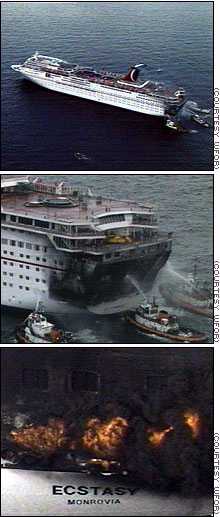On the afternoon of July 20, 1998, the Liberian passenger
ship Ecstasy had departed the Port of Miami, Florida, en route to Key
West, Florida, with 2,565 passengers and 916 crewmembers on board when
a fire started in the main laundry shortly after 1700. The fire migrated
through the ventilation system to the aft mooring deck where mooring lines
ignited, creating intense heat and large amounts of smoke. As the Ecstasy
was attempting to reach an anchorage north of the Miami sea buoy, the
vessel lost propulsion power and steering and began to drift. The master
then radioed the U.S. Coast Guard for assistance. A total of six tugboats
responded to help fight the fire and to tow the Ecstasy. The fire was
brought under control by onboard firefighters and was officially declared
extinguished about 2109. Fourteen crewmembers and eight passengers suffered
minor injuries. One passenger who required medical treatment as a result
of a pre-existing condition was categorized as a serious injury victim
because of the length of her hospital stay. Carnival Corporation, Inc.,
the owner of the Ecstasy, estimated that losses from the fire and associated
damages exceeded $17 million.
The National Transportation Safety Board determines that the
probable cause of fire aboard the Ecstasy was the unauthorized welding
by crewmembers in the main laundry that ignited a large accumulation
of lint in the ventilation system and the failure of Carnival Cruise
Lines to maintain the laundry exhaust ducts in a fire-safe condition.
Contributing to the extensive fire damage on the ship was the lack
of an automatic fire suppression system on the aft mooring deck
and the lack of an automatic means of mitigating the spread of smoke
and fire through the ventilation ducts.
The major safety issues discussed in this report are as follows:
• Adequacy of management safety oversight;
• Adequacy of the fire protection systems;
• Adequacy of passenger and crew safety; and
• Adequacy of engineering system design.
|
 |
|
|



